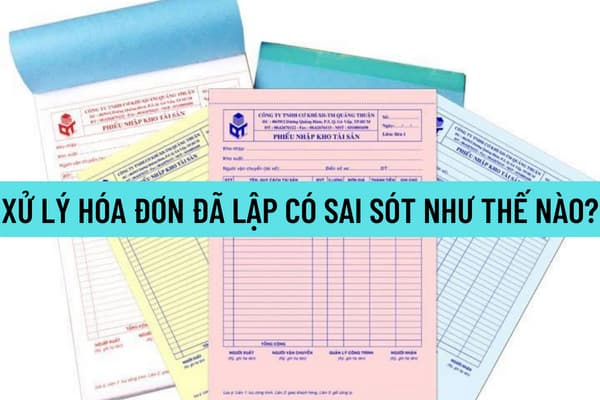Guidance on Handling Issued Value-Added Tax Invoices with Errors According to Decree 15/2022/ND-CP
Which entities are eligible for VAT reduction under Decree 15/2022/ND-CP?
According to Article 1 of Decree 15/2022/ND-CP, the regulations on VAT reduction are as follows:
VAT Reduction
1. VAT reduction applies to the groups of goods and services currently subject to a 10% tax rate, except for the following groups of goods and services:
a) Telecommunications, financial activities, banking, securities, insurance, real estate business, metal and pre-manufactured metal products, mineral products (excluding coal mining), coke, refined petroleum products, and chemical products. Details are in Appendix I attached to this Decree.
...
2. VAT rate reduction
a) Business establishments that calculate VAT by the deduction method are entitled to apply an 8% VAT rate for goods and services specified in Clause 1 of this Article.
...
5. In cases where business establishments have issued invoices and declared VAT at the tax rate or percentage that has not been reduced according to this Decree, the seller and the buyer must draw up a record or have a written agreement specifying the errors. The seller then issues an adjusted invoice and provides the adjusted invoice to the buyer. The seller adjusts the output VAT and the buyer adjusts the input VAT based on the adjusted invoice (if any).

Guidance on handling issued VAT invoices with errors according to Decree 15/2022/ND-CP (Image from the Internet)
Regulations on handling invoices with errors
According to Article 19 of Decree 123/2020/ND-CP, the regulations on handling invoices with errors are as follows:
Handling invoices with errors
...
2. In cases where electronic invoices with a tax authority’s code or electronic invoices without a tax authority’s code have been sent to the buyer and the buyer or seller discovers errors, the handling is as follows:
a) If there is an error in the buyer's name or address, but the taxpayer identification number (TIN) is correct and other details have no errors, the seller notifies the buyer of the invoice error without reissuing the invoice. The seller notifies the tax authority of the erroneous electronic invoice using Form No. 04/SS-HDDT in Appendix IA attached to this Decree, except for cases where the erroneous electronic invoice without the tax authority's code has not been sent to the tax authority.
b) If the error involves the TIN, amount recorded on the invoice, tax rate, tax amount, or incorrect specifications or quality of goods, one of the following two methods can be used:
b1) The seller issues an electronic adjustment invoice for the erroneous invoice. If there is an agreement between the seller and the buyer about creating a written agreement before issuing the adjustment invoice for the erroneous invoice, the seller and the buyer create a written agreement specifying the errors, then the seller issues the electronic adjustment invoice.
The electronic adjustment invoice must include the phrase “Adjustment for invoice sample number... sign... number... dated... ”.
b2) The seller issues a new electronic invoice to replace the erroneous electronic invoice, except when the seller and the buyer agree on creating a written agreement before issuing the replacement invoice for the erroneous invoice. The seller and the buyer create a written agreement specifying the errors, then the seller issues a new electronic invoice to replace the erroneous one.
The new electronic invoice must include the phrase “Replacement for invoice sample number... sign... number... dated... ”.
The seller signs the new electronic invoice for adjustment or replacement of the erroneous electronic invoice, then sends it to the buyer (for electronic invoices without a tax authority’s code) or sends it to the tax authority for approval, which then forwards it to the buyer (for electronic invoices with a tax authority’s code).
Thus, the handling of erroneous invoices is regulated as above.
Guidance on handling issued VAT invoices with errors according to Decree 15/2022/ND-CP
In Official Dispatch 46350/CTHN-TTHT of 2022, the Hanoi Tax Department provides guidance on handling issued invoices with errors according to Decree 15/2022/ND-CP as follows:
+ In cases where the Company calculates VAT by the deduction method, supplies goods and services subject to a 10% VAT rate, and does not fall under the categories of goods and services specified in Appendices I, II, III attached to Decree 15/2022/ND-CP, the 8% VAT rate is applied from February 1, 2022, to December 31, 2022, according to Clause 2, Article 1 of Decree 15/2022/ND-CP.
+ In cases where the Company produces and trades in basic chemicals and applies a 10% VAT rate, the VAT reduction is governed by the regulations in Decree 15/2022/ND-CP.
+ In cases where the Company produces and trades in basic chemicals, applies a 10% VAT rate, and qualifies for VAT reduction under Decree 15/2022/ND-CP, but the Company has issued invoices and declared VAT at the tax rate or percentage that has not been reduced as prescribed by this Decree, the seller and the buyer must draw up a record or a written agreement specifying the errors. The seller then issues an adjusted invoice and provides the adjusted invoice to the buyer. Based on the adjusted invoice, the seller adjusts the output VAT and the buyer adjusts the input VAT (if any) according to the provisions of Clause 5, Article 1 of Decree 15/2022/ND-CP, Clause 2, Article 19 of Decree 123/2020/ND-CP.
The above content is from Official Dispatch 46350/CTHN-TTHT of 2022 issued by the Hanoi Tax Department.
LawNet
